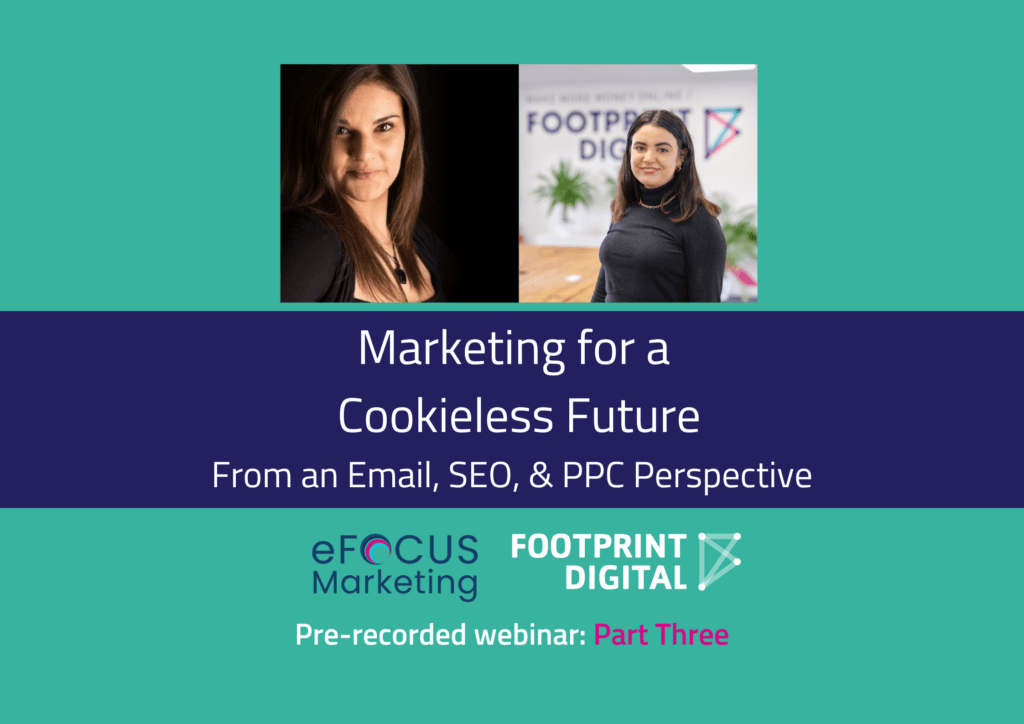
If you haven’t already, you can watch part one here and part two here.

This is the concluding session of our three part webinar with Kate at eFocus Marketing. In this session, Kate and Kaya will focus on recency, frequency, and monetary value audience segments in email marketing and wrap up the whole webinar.
Recency, frequency, and monetary value segments
Kaya Heaton: The last use case we’re going to look at is recency, frequency, and monetary value segments. So, some things to consider here, we can look at:
- Website landing page optimisation,
- Purchase history and website behaviour,
- Creating VIP customer content,
- Better qualified and more relevant PPC ads,
- Remarketing and automation.
This is again looking at how we segment the audience. How recently they have bought with you, how frequently are they buying with you and what monetary value do they represent? It’s completely dependent on the kind of business that you’re running, frequency with which you’d expect people to be buying from you.
What we want as businesses is advocacy and loyalty.
We want that stage of the funnel to really be well developed. How can we think about all of these different strategies to make sure that we’re doing that?
How can we optimise our landing pages so that people are coming through from email if they are a loyal subscriber, and where are you taking them to on your website?
With VIP customer content, again we’re going back to the idea of what emails are you sending out? What data are you basing that off of and what offers and custom and kind of VIP content could you be using there?
All of this data leads to better qualified, more relevant content, not everything is relevant for everyone, but we can start feeding that into remarketing and automation and getting those wheels turning for making all kinds of channels work together and cross-pollinate.
Kate Barrett: This also really links to what we were talking about in the first part of our webinar.
This is coming from the top of that data pyramid from that purchase data and it’s understanding who those groups of people are. The basic example is ‘never purchased from you before’ versus ‘had purchased from you before’. So for each of the recency, frequency, and monetary value segments, each email subscriber is given a score and those three scores are added up. The ones that have a high score are your VIPs.
You can create segments all the way down to the users who have probably never bought from you before and never spend anything with you.
Tailored Personalisation
You can then go into your one-to-one personalisation. For example, if you’re looking at your VIP segment, how can we personalise it? The products that are showing for every person that receives the email are going to be different based on what they’ve bought before using dynamic content.
Here we can bring in other areas of that data pyramid. We can think about email engagement from our last scenario in the 2nd part of our webinar series, whether they’re active or passive or inactive.
If they’re customers that are in the VIP segment but they’re also passive we need to try to hold on to them. We need to be careful with them. We nurture them a little bit more. If they’ve unengaged from emails, reduce that frequency down and don’t send them so many emails. If you’re sending an email once a week, maybe reduce that down to once every two weeks.
We can then look at the rest of the engagement data to give us recency, frequency, and monetary analysis and a deeper understanding of how we connect the right message to the right person at the right time in their journey. This is really breaking down between the consideration stage and the loyalty stages of the journey.
Think about how many times somebody’s bought because the more frequently they’ve bought from you changes the way you want to deal with them versus somebody who’s only bought from you once. These two people will have very different content needs.
Think about how you can learn from all of the different channels and bring that knowledge in so that you can create different strategies for each segment. Encourage and reward loyalty. For those High RFM customers, how do you reward them specially? How do you make sure that for those that are in that middle ground you’re pushing them through to those repeat purchases?
Dynamic Content
When you connect all of that together, you can start to think about the types of campaigns that you might want to send out.
The first example is if you identify those subscribers that haven’t purchased from you as part of your welcome series you can send an email with a piece of dynamic content that offers that segment a percentage off their first order.
Another example is thinking about nurturing subscribers through a conversion stage. So we’ve got an example here (in the video) from Indeed. For them, a conversion is signing up and uploading your resume.
How can they support that process and nurture that purchaser through to make sure that they feel supported and start to build that loyalty. What Indeed do here is have different focuses and different areas of support, different elements that a converted person can go through to.
Now if we think about a product based company you might focus on upsell and cross-sale but what could be better here is providing help and support with the product or products that they’ve just bought.
One of the great things that you can do is include a video with your emails to show them how to clean that product, look after it, fit it properly or whatever it is for your business, but we want to support them and nurture them through that purchase process.
Experience is everything and this is what’s going to drive loyalty.
For the next example, if you’ve got a platform, or a piece of software or a membership that you’re selling to somebody, help them get to that next stage where you’re selling the products.
So, we mentioned that videos showing people how to use your products or services can be really useful. Then think about where you provide other forms of assistance, you could direct people to your forum or tutorials and tell them how to reach out for help and support. How do they get in touch with your customer services?
Speak directly to your customer services teams and find out what those frequent questions post-purchase are. They will have a list of common questions that come up about the service or product which can be very useful for your email content. Not only will it help people if you answer their questions in email content, it will also reduce pressure on your customer service teams.
When you’re reactivating those inactive customers, we’ve got a couple more examples here building on what we spoke about earlier whether that is bringing them through to ‘buy again’ through an offer or highlighting those features that they’re currently missing by not being an active customer with you.
It’s really important to look at those life cycles and how you can push them to that next stage. And then just to wrap us up as the final example here for inactive customers again reiterating those benefits of why they come back and purchase from you and really prompting that action.
Concluding the webinar
Kaya Heaton: That brings us to the conclusion of the webinar. All of these individual channels that we’ve spoken about throughout the last three videos are great individually.
But when they’re used effectively together, they can inform strategy and become even more valuable.
The core of all of this is knowing your audience, knowing the problem you’re solving for them, knowing why and through what channels they want to be communicated with and all of these different ways and methods of marketing to our audiences can be added together – they can cross-pollinate.
Marketing channels and your marketing data can be cyclical and become even more valuable and help you drive more and more relevant high quality data-led traffic through to your websites.
So, to conclude, thank you so much for spending your time watching this session.
Please feel free to connect with us on LinkedIn and both Footprint Digital and eFocus Marketing have brilliant books available as well to delve more into all of these topics and into how we can all make most of the data that we have access to and drive even more success online.
Thank you.







